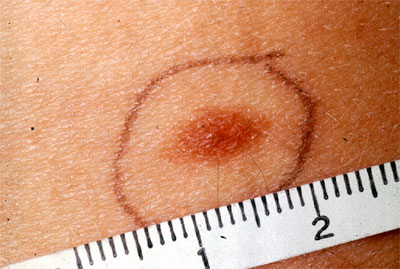|
|
|
Dysplastic nevi
Synonym:
Atypical nevi, Atypical moles
The term dysplastic nevus has been used to refer to both clinically atypical nevi (moles) and to histologically atypical nevi. The term dysplastic is best restricted to cytologic dysplasia seen on histology, with the word "atypical" being used clinically.
Most nevi evolve through stages from flat, dark, junctional nevus to raised, mid-brown, compound nevus, to polypoidal skin colored dermal nevus, which in turn drop off in old age.
Dysplastic nevi tend not to go through these stages of maturation, but retain many of the features of the young junctional nevus. Although large, they continue to expand peripherally as an only slightly raised lesion.
Dysplastic nevi occur sporadically, presumably secondary to actinic damage, or as part of an autosomal dominant trait called the dysplastic nevus syndrome (DNS) or the multiple mole melanoma syndrome.
Patients with the DNS show a greatly increased incidence of malignant melanoma.
Clinically atypical nevi can be divided into three groups of ascending risk of histologic dysplasia:
Minimally atypical nevus
The minimally atypical nevus is a nevus that is clinically atypical, but which shows a tendency towards maturation. The usual morphology is a large nevus, with an elevated soft, wrinkled surface over the entire lesion or centrally. When only the center is raised and there is a flat surround component, the lesion resembles a "fried egg".
Moderately atypical nevus
The moderately atypical nevus shows irregularly irregular variation in color and edge. It is not symmetrical. Color variation and edge variation suggests a genotypic instability, manifesting as instability of melanin production and cellular growth rate.
Severely atypical nevus
The severely atypical nevus is clinically indistinguishable from melanoma in situ. Severely atypical lesions show considerable variation of edge and color and are not symmetrical.
Treatment:
- Family members of a patient with a dysplastic nevus should be examined for evidence of the dysplastic nevus syndrome. Such individuals should avoid excessive sun exposure.
- It is recommended that patients with atypical or dysplastic nevi have their skin examined on an annual basis.
- Minimally dysplastic nevi do not usually require removal, with removal being necessary only if they are evolving into an increasingly atypical lesion.
- Moderately atypical lesions can be excised, or must be followed closely. Moderately atypical nevi appear to be at significant risk for evolving into severely dysplastic nevi, and therefore melanoma.
- Severely atypical lesions should be surgically excised, as it is not possible to separate them with any degree of certainty from an early superficial spreading melanoma.

Back to Dermatology Glossary - D Index |
Back to Dermatology Glossary Index
|